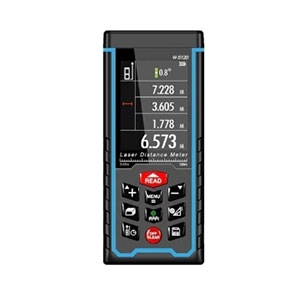A laser distance meter is an instrument that accurately measures the distance to a target using laser technology. During operation, the laser distance meter emits a thin laser beam towards the target, and the reflected laser beam is captured by photoelectric components. The timer measures the time it takes for the laser beam to travel from emission to reception, calculating the distance from the observer to the target. Laser distance meters are known for their lightweight, compact size, simple operation, speed, and high accuracy, with an error rate only one-fifth to a few hundredths compared to other optical range finders. In this article, sisco will introduce the working principles of laser distance meters for a better understanding.
Basic Principles of Laser Distance Meter
Laser distance meters generally adopt two measurement methods: pulse method and phase method.
Pulse Method
In the pulse method, the laser emitted by the distance meter is reflected by the measured object and received by the distance meter. Simultaneously, the distance meter records the time taken for the laser to travel back and forth. The distance between the distance meter and the measured object is calculated as half the product of the speed of light and the round-trip time of the laser. The accuracy of distance measurement in the pulse method is typically around +/-1 meter, and these devices have a measurement blind zone of approximately 15 meters.
Laser ranging is a method of distance measurement using light waves. If light travels with a speed 'c' in the air between points A and B, the distance 'D' between A and B can be expressed as follows:
D=ct/2
where:
- D is the distance between points A and B.
- c is the speed of light in the atmosphere.
- t is the time required for light to travel round trip between A and B.
From the above formula, it is evident that measuring the distance between A and B is essentially measuring the time 't' it takes for light to propagate. Depending on the measurement method, laser distance meters are typically classified into pulse-type and phase-type.
Phase Method
A phase-type laser distance meter uses radio frequency modulation to modulate the amplitude of the laser beam. It measures the phase delay generated by the modulation light during one round-trip and then calculates the distance represented by this phase delay based on the wavelength of the modulation light. It indirectly determines the time required for light to travel round trip.
Phase-type laser distance meters are commonly used in precise distance measurements. Due to their high accuracy, typically in millimeters, and to ensure effective reflection signals, these distance meters are equipped with reflectors known as cooperative targets. Assuming the angular frequency of the modulation light is ω, and the phase delay produced during one round trip on the distance D to be measured is φ, the corresponding time t can be expressed as:
t=φ/ω
Substituting this relationship into the distance formula, D can be represented as:
D=1/2 ct=1/2 c*φ/ω=c/(4tf)(Nπ+Δφ)
=c/4f(N+ΔN)=U(N+)
where:
- φ is the total phase delay produced during one round trip of the signal.
- ω is the angular frequency of the modulation signal, ω=2πf.
- U is the unit length, equal to 1/4 of the modulation wavelength.
- N is the number of half wavelengths included in the measurement line.
- Δφ is the part of the phase delay produced during one round trip of the signal that is less than π.
- ΔN is the fractional part of half the modulation wave included in the measurement line, ΔN=φ/ω.

Under given modulation and standard atmospheric conditions, the frequency c/(4πf) is a constant. Distance measurement now becomes the measurement of the number of half wavelengths included in the measurement line and the fractional part less than half a wavelength, namely the measurement of N or φ. Due to advances in modern precision machining and radio phase measurement technology, the measurement of φ has achieved high accuracy.
To measure the phase angle φ less than π, various methods can be used, with delay phase measurement and digital phase measurement being the most commonly applied. Currently, short-range laser distance meters adopt digital phase measurement principles to obtain φ.
In summary, in the described situation, phase-type laser distance meters use a continuously emitted laser beam with a modulated signal. To achieve high-precision distance measurement, cooperative targets are needed. The recently introduced handheld laser distance meter is a new type of distance meter in the pulse-type category. It is not only compact and lightweight but also adopts digital phase measurement pulse width modulation technology. It achieves millimeter-level accuracy without the need for cooperative targets, with a measurement range exceeding 100 meters, and can rapidly and accurately display distances. It represents the latest standard measuring instrument for precise engineering measurements and building area measurements in short-range applications.
The above explains the working principles of laser distance meters, hoping to help you better understand these devices.

